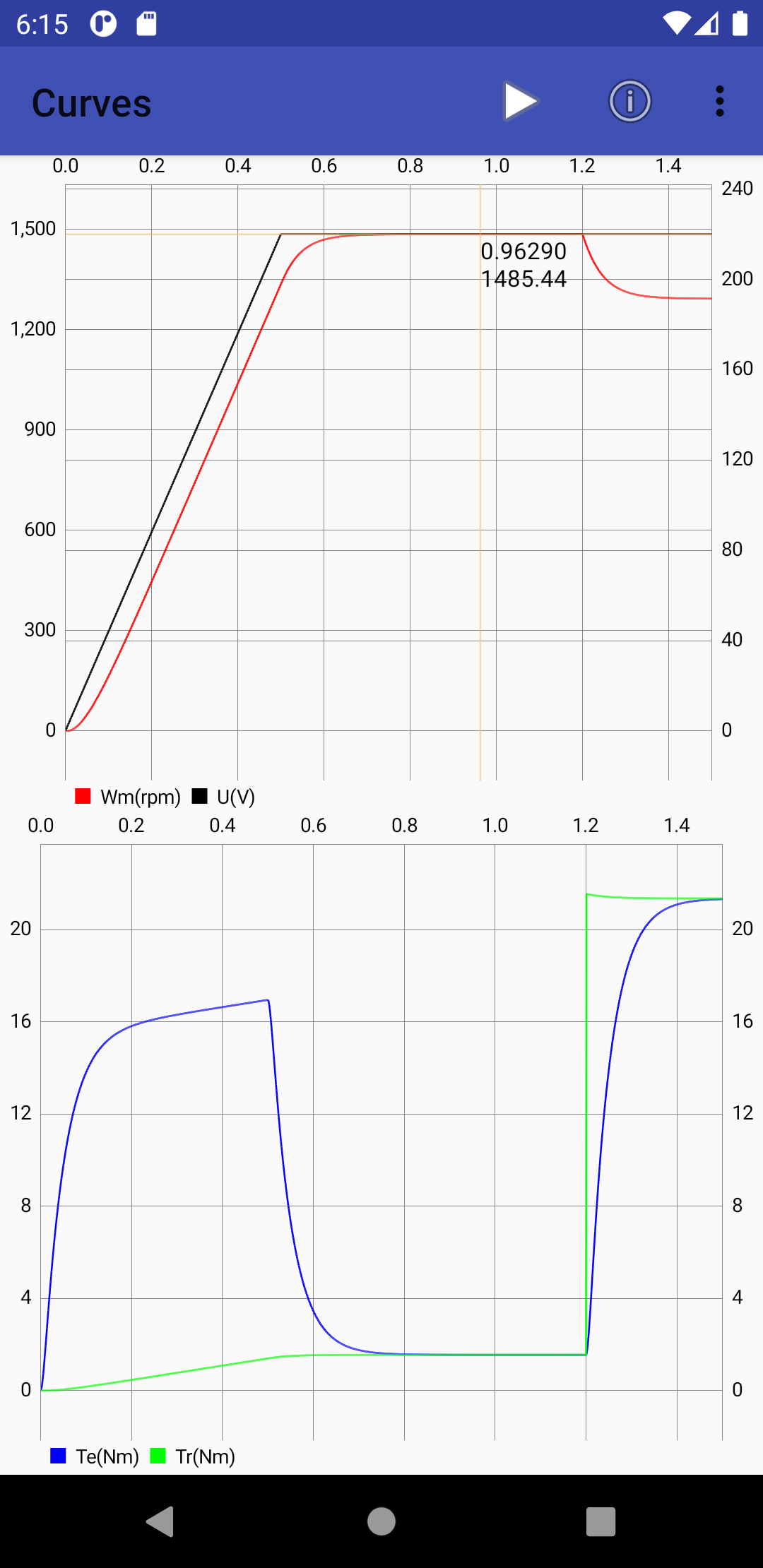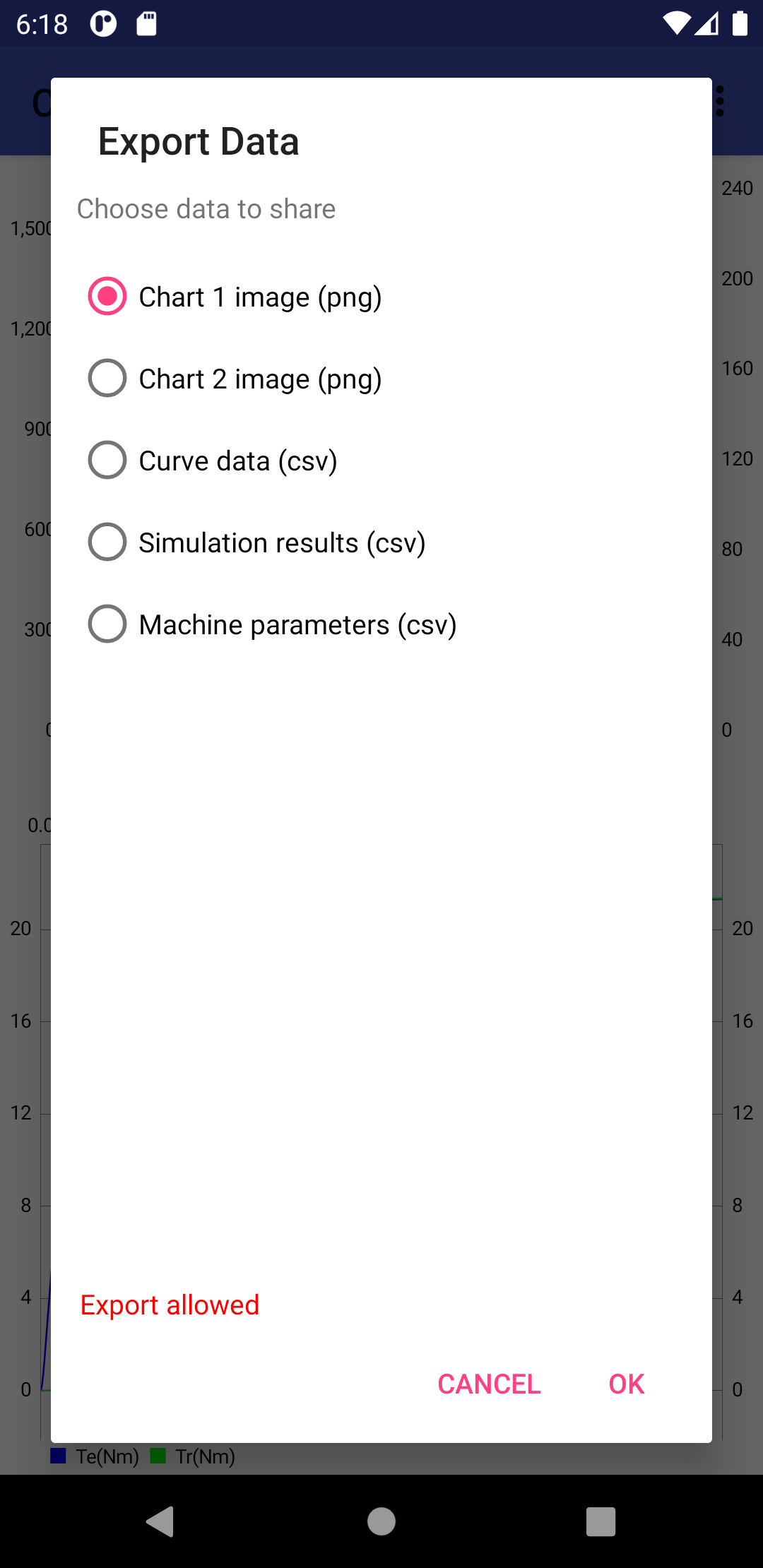Help for the DC Motor App: Simulation of a DC Motor
Introduction
This application allows to simulate the DC motor in transient and steady state and to visualize curves and values.
It allows to choose between 4 operating modes:
- Ramp start: The armature voltage rises in a ramp
- Voltage step: The armature voltage is imposed in step
- Fixed shaft: Locked rotor test
- Speed drop: Speed Release Test, Motor Not Powered
Thank you for considering a 5-star vote for this app, which will allow its wide dissemination to the community of students and teachers of Electrical Engineering.
If you have any concern, please let me know before voting, by email:
I could certainly provide explanations, without getting a vote below 5 stars.
I am a teacher-researcher in EE: Researchgate Profil
Thank you for encouraging the development of this kind of apps, by contributing through an in-app purchase of the Premium offer.
Summary
The DC Motor App helps students and teachers to study and understand the operation of the Direct Current Motor (DCM) in transient and steady state.
Several events can be applied during the simulation, such as changes in load torque at different times, armature voltage steps, excitation current, as well as resistive parameter variations.
Simulations can be shared and exported to other apps (Gmail, photos, Excel sheets, documents).
Main characteristics:
- Simulation of the Direct Current Motor (DCM) in transient and steady state.
- Curves of armature current, excitation current, armature voltage, speed, electromagnetic and load torque, power, as a function of time and in steady state
- Different operating modes
- Change motor parameters and save them in local files
- Apply several load torque events, armature voltage... in the simulation
- Simulation parameters (final time, step time...)
- Displays the curves by splitting the window into 2 graphs, with zoom and display of values on the curve point
Premium Version:
- Additional events (armature voltage, excitation current, armature resistance) instead of only load torque events
- Display an infinity of curves on the 2 graphs with selection of the color, the top/bottom position and the primary or secondary Y-axis of the graph. It is limited to 3 curves in the basic version
- Load previously saved configuration, and also share them by email
- Export data: graph images, graph data (xls/csv), machine parameters
- And of course you help the developer, who is a teacher and researcher in electrical engineering, in his approach to develop educational apps
Video
Youtube
Navigation
Through 6 screens or views, you access the different configurations and parts of the application.
You navigate by sliding (swipe) the different views laterally or
By selecting the corresponding view from the menu 
You can also, from the home screen  ,
,
click on the part of the diagram that represents the configuration or the view in question.

Simulation: Click on power supply (U, I) (rouge) to access simulation parameters.
Curves: Click on excitation part (I1) (violet) to display curves.
Results: Swipe views or from the menu to view the results.
Events: Click on the load (green) to access simulation events.
Parameters : Click on the motor (blue) to change its parameters.
Simulation
The "Simul. Parameters" view allows you to choose the different simulation options to apply.
By clicking on the power supply (U, I) (red) of the home screen diagram,
we can choose between 4 modes:
- Ramp start: The voltage rises linearly for tr(s) until reaching the final voltage U0(V)
- Voltage step: The voltage U0(V) is applied suddenly
- Fixed shaft: The machine behaves like an inductor and a resistor
- Speed drop: No power, the motor slows down with its friction and load torque from the initial speed WmLV(rpm)

Other numeric parameters are grouped in a table. These parameters can be changed by a long press on the row of the table.
We choose the simulation time (tf), the calculation step (dt= 1.e-4s)
The DS (down sampling) allows you to save only one point every DS (10 for example).
This is particularly useful when the time constants of the DCM are small or with the PWM and we must decrease the computation step but we do not want to have curves with many points that would make their display and handling heavy.
For the curves, we must choose the color then the position (in the top or bottom graph) and if it uses the main Y-axis (left) or the secondary Y-axis (right). Finally, we add the curve to the left panel.
A long press on a curve line erases it.
Curves
The "Curves" view allows you to see the instantaneous curves of the motor variables.
It is also accessed by launching the simulation using the Run icon

The results are then displayed:

We can choose in the Simulation view, the curves to be displayed.
Results
The "Results" view is used to display the numerical values of the quantities for a given point.
However, if we click on the curves, a point appears and the calculation is done again for this point.
It is better to navigate to the Results view, with the menu to avoid changing this point, by dragging the view laterally.
If we want more variables, we must add the corresponding curve before making simulation

Events
The "Events" view allows you to choose the different events to apply.

A long press on a row of the added events table allows you to change the application time of the event and its value.
Several events can follow each other, for example, U=150 V at t=0.4s, then U=200 V at t=0.8s, then Cr=20 Nm at t=1.2s.
Other types of events can be added such as the variation of the resistance and the excitation current (Premium option).
IM Parameters
The "Motor Parameters" view allows to choose the different electromagnetic and mechanical parameters of the DC motor.

The menu  also allows you to choose DCM Parameter saving.
also allows you to choose DCM Parameter saving.
The chosen name must have a .dcfg extension to be recognized when receiving such a file sent via Gmail or other programs.
You can also choose Loading Settings from backups, this is a Premium option.
The Share menu (Premium) allows you to send the DCM parameters file to other devices / users, for example via Gmail.
The Exports menu (Premium) is extremely useful and allows you to send the curve image to other apps, such as File Manager, Viber or Gmail.

For data, you can send the data to the file manager to save a file, data .csv for example, which you can then send by email or open with Excel or Sheets app.
This very interesting option makes it possible to use the results of the simulation later using the generated .csv file.
This information is also available online
and on Youtube.
If you want to contact us, please use the email:






